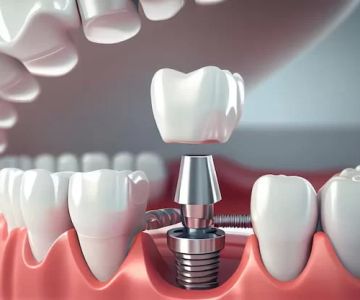The Cost of Dental Crowns and How Insurance Helps: A Guide to Affordable Dental Care
- Understanding Dental Crowns and Their Purpose
- Factors Affecting the Cost of Dental Crowns
- How Insurance Helps Cover the Cost of Dental Crowns
- Choosing the Right Dental Insurance Plan for Crowns
- Real-Life Experiences and Stories
Dental crowns are caps that are placed over a damaged tooth to restore its size, shape, and function. They're commonly used to treat teeth that are decayed, cracked, or weakened, offering both functional and cosmetic benefits. Crowns can be made from a variety of materials, including porcelain, metal, or a combination of both, depending on the location of the tooth and the patient's preferences.
For anyone considering dental crowns, it's important to understand their purpose, how they fit into the overall treatment plan, and why they might be recommended by a dentist. Crowns can be a life-changing solution for restoring damaged teeth, giving patients the ability to chew comfortably again and enhancing their smile. However, the cost of dental crowns can be a concern for many, especially without insurance coverage.
Factors Affecting the Cost of Dental Crowns
The cost of dental crowns can vary significantly depending on several factors. Here are the primary factors that influence the price:
- Material Type: Porcelain crowns tend to be more expensive than metal crowns due to their aesthetic appeal and natural appearance. The material you choose can greatly impact the final cost of your crown.
- Tooth Location: Crowns placed on back teeth (molars) are usually more expensive than those placed on front teeth because they require more durability and may require more complex procedures.
- Geographical Location: The cost of dental crowns can also vary based on the location of the dental practice. In larger cities like New York or Los Angeles, dental services tend to be more expensive than in rural areas.
- Complexity of the Procedure: If additional procedures such as root canals or extractions are required before placing the crown, the cost will increase accordingly.
- Dental Professional Expertise: The experience and reputation of the dentist performing the procedure can influence the price. Highly skilled specialists may charge more for their expertise.
How Insurance Helps Cover the Cost of Dental Crowns
Dental insurance can significantly reduce the cost of dental crowns. However, the amount of coverage depends on the specifics of your plan. Most dental insurance policies cover a portion of the cost of crowns, but the extent of that coverage can vary. Here's how insurance typically works:
- Coverage Percentage: Most dental insurance plans cover around 50-80% of the cost of a crown, with the patient responsible for the remaining balance. The exact percentage depends on whether the procedure is considered medically necessary or cosmetic.
- Annual Maximums: Many dental insurance plans have an annual maximum limit for benefits, typically ranging from $1,000 to $2,000. This means that once you've reached the maximum amount for the year, you’ll need to cover any remaining expenses out-of-pocket.
- Waiting Periods: Some insurance plans may impose a waiting period before they cover procedures like crowns. Make sure to check your policy to see if there are any waiting periods that might delay your coverage.
- In-Network vs. Out-of-Network: Insurance coverage is often higher when you use a dentist within the plan’s network. If you choose to go out-of-network, you may need to pay more for your crown procedure.
Understanding these details can help you plan your dental treatments and reduce the overall out-of-pocket expenses associated with dental crowns.
Choosing the Right Dental Insurance Plan for Crowns
When selecting a dental insurance plan, it's important to consider your needs and the cost of dental crowns. Some plans may offer better coverage for restorative procedures like crowns, while others may focus more on preventive care. Here are some tips for choosing the right insurance plan:
- Review Coverage Options: Ensure that the plan covers crowns, as not all dental plans include them. Look for plans that offer comprehensive restorative care, especially if you're likely to need crowns in the future.
- Check for Waiting Periods: If you need immediate dental work, make sure to choose a plan with short or no waiting periods. Some plans have a waiting period before covering major procedures.
- Compare Annual Maximums: Choose a plan that offers an annual maximum limit high enough to cover the cost of a crown and any other dental work you may need throughout the year.
- Look for Network Options: If you have a preferred dentist, ensure they are within your plan's network to minimize costs.
Real-Life Experiences and Stories
One of the best ways to understand the cost of dental crowns and how insurance helps is by hearing real-life stories. Many patients have shared their experiences about how insurance coverage made the process of getting a crown more affordable.
For instance, Sarah, a 35-year-old woman from California, had a cracked molar that required a crown. After reviewing her insurance policy, she learned that her plan would cover 60% of the cost. With the insurance contribution, Sarah only had to pay $300 out of pocket for a high-quality porcelain crown, which would have otherwise cost over $1,000.
These kinds of stories highlight how dental insurance can significantly reduce the financial burden of expensive dental procedures like crowns. Understanding your coverage and making an informed decision about your insurance plan can make a big difference in managing costs.
Are you looking for more information on the cost of dental crowns and how insurance can help? Visit Dentistry Toothtruth for expert advice and to explore your options for affordable dental care!







 Summit Dental Care4.0 (124 review)
Summit Dental Care4.0 (124 review) Fair Oaks Orthodontics5.0 (29 review)
Fair Oaks Orthodontics5.0 (29 review) Dental Care of North Fort Myers4.0 (708 review)
Dental Care of North Fort Myers4.0 (708 review) Sarkissian Dentistry: Robert Sarkissian, DDS, MAGD5.0 (84 review)
Sarkissian Dentistry: Robert Sarkissian, DDS, MAGD5.0 (84 review) Root 66 Endodontics4.0 (16 review)
Root 66 Endodontics4.0 (16 review) Scott Soderquist, DDS, MS0.0 (0 review)
Scott Soderquist, DDS, MS0.0 (0 review) The Importance of Oral Health Education During Pregnancy for a Healthy Pregnancy
The Importance of Oral Health Education During Pregnancy for a Healthy Pregnancy Best Tips for Brushing Your Teeth Properly for Healthy Gums: Essential Techniques for Oral Health
Best Tips for Brushing Your Teeth Properly for Healthy Gums: Essential Techniques for Oral Health Why Skipping Dental Checkups Can Lead to Bigger Oral Health Problems
Why Skipping Dental Checkups Can Lead to Bigger Oral Health Problems Advantages of Porcelain Dental Restorations
Advantages of Porcelain Dental Restorations How Can Diabetes Cause Tooth and Gum Problems? Preventing and Managing Oral Health Issues
How Can Diabetes Cause Tooth and Gum Problems? Preventing and Managing Oral Health Issues Healthy Habits for Promoting Good Oral Health and Hygiene: Tips for a Healthy Smile
Healthy Habits for Promoting Good Oral Health and Hygiene: Tips for a Healthy Smile